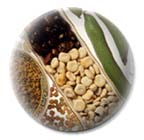- Home
- Introductions

|
Vegetable Seed Production: SpinachYou are here: Seed Production: Chenopodiaceae: Spinach
Botany Most plants in the Chenopodiaceae family have small single flowers and plants are bisexual or unisexual, sometimes dioecious. In some cases two or more flowers grow together in a dense cluster and form a multiple fruit called a utricle that contains multiple embryos.Spinach has a distinctive vegetative phase, this cool season annual plant forms a short compressed stem and a rosette of leaves. The leaf, both petiole and blade, are used for food. Harvesting is done only during the rosette stage. At the induction of the reproductive state, caused by long days and high temperatures, the primary stem elongates (bolts) with a disruption of the rosette. After bolting occurs the crop is no longer suitable for harvest. Soil Nutrition Spinach is sensitive to acid soils and the pH should be maintained above 6.0. The crop is not an especially heavy feeder. On fertile alluvial soils, usually only modest fertilization is needed in conjunction with soil test results (e.g. test apply test). On lighter sandy soils, high quantities of N-K-P may be needed. Like beets, spinach is tolerant of saline soil conditions and is considered to be a halophyte. Isolation Spinach is mainly wind pollinated. Recommended isolation distances are therefore up to 1000 m in some countries, although some authorities stipulate only 500 m for production of commercial seed cultivars within the same type (e.g. leaf type and seed type). Planting Commercial fields for processing are often scatter-planted at high density in broad rows at the edges of each bed, but too high plant density produces weak petioles and accelerates seed stalk development. Bunching spinach is often precision planted in multiple rows on the outer edges of a standard 40 inch bed. Spinach germinates at soil temperatures above 35 degrees F but optimum germination occurs at 70 degrees F. Irrigation Spinach has a shallow root system and must receive a consistent supply of water to maintain growth and ensure the leaves are tender and not tough. On mineral soils in the East, overhead irrigation is used. In California overhead irrigation is sometimes used to establish the crop but furrow irrigation is used later in the season. The requirement of one inch per week applies to this crop. Roguing 1. Before main flowering (when rosette formed), remove non-rosetting and early flowering male plants and plants not true to type.
Seed Harvest In the seed producing areas with relatively calm and dry weather conditions, the crop is harvested with a combine when the plants are dry and the majority of seeds are mature. This practice leads to considerable loss from shattering and birds, and in other areas the crop is cut and placed in windrows to dry as soon as the plants start to dry out and the earliest seeds are mature. An approximate guide to this stage in a crop is when the later ripening plants start to become yellow. Stacks left to dry must be on sheets to avoid loss from shattering. Cleaning Spinach seed from cut and dried plants is threshed with a small-drum thresher or a cereal thresher. In the latter case the recommended drum speed is about 700 rpm, and the concaves are set relatively wide to minimize the amount of broken stalks. In addition to separating the seeds from the plant, the threshing operation breaks up the clusters of seeds. Seed Yield Seed Identification:
|
||||||||||||||||||||